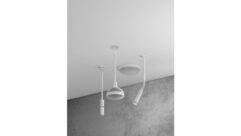Miking a Conference Room
Whenever multiple sound sources must share one microphone, microphone selection and placement is important to ensure consistent audio levels.
Whenever multiple sound sources must share one microphone, microphone selection and placement is important to ensure consistent audio levels.
1. Microphone type
Boundary mics are less noticeable on camera, but may pick up noise from paper rustling, pencil-tapping, etc., since these sounds occur very close to the mic.
Gooseneck mics are aimed up and over the potentially noisy table surface, reducing noise pickup and preventing the mic from being covered up by books or other materials.
2. Polar pattern
The cardioid pattern has a useful angle of about 120 degrees, which can easily accommodate two adjacent talkers. The cardioid pattern is least sensitive to sounds coming from the rear of the mic, which reduces pickup of sound coming from loudspeakers mounted at the front of the room.
The supercardioid pattern has a working angle of about 100 degrees. It is less sensitive than the cardioid to sounds coming from above the microphone, but it is somewhat more sensitive to sounds coming from directly behind the mic.
Omnidirectional mics are equally sensitive to sound from all directions. While they are useful for picking up several talkers seated around the mic, feedback problems usually restrict their use to recording-only systems without sound reinforcement.
3. Use one microphone for every two participants
Because each talker is equally off-axis from the center-line of the mic, their levels will be the same (assuming that they speak equally loud and are seated an equal distance from the mic).
If you try to cover more than two people with each mic, the talkers on the sides will be noticeably softer (3 dB to 6 dB) than the talker in the center, because they are farther off-axis. This effect is more noticeable with the supercardioid pattern than with the cardioid pattern, because the supercardioid’s pickup falls off more rapidly as the sound source moves away from the centerline of the mic.
Source: Shure Inc.










